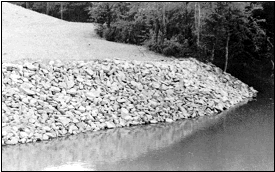
|

|
To Print Use The pdf File
ILLINOIS URBAN MANUAL
PRACTICE STANDARD
STRUCTURAL STREAMBANK
STABILIZATION
(feet)
CODE 940
 (Source: NC Erosion and Sediment Control Field Manual) |
DEFINITION
Stabilization of eroding streambanks by use of designed structural measures.
PURPOSE
The purpose of this practice is to protect streambanks from the erosive forces of flowing water.
CONDITIONS WHERE PRACTICE APPLIES
Sections of streambanks that are subject to erosion due to excessive runoff from construction activities. Generally applicable where flow velocities exceed 5 ft/sec or where vegetative streambank protection is inappropriate.
CRITERIA
Since each reach of channel requiring protection is unique, measures for structural streambank protection should be installed according to a plan based on specific site conditions.
Develop designs according to the following principles:
Riprap - Riprap is the most commonly used structural material for stabilizing streambanks. When possible, slope banks to 2:1 or flatter, and place a gravel filter or filter fabric on the smoothed slopes before installing riprap. Place the toe of the riprap at least 1 foot below the stream channel bottom or below the anticipated depth of channel degradation. Where necessary, riprap the entire length between well-stabilized points of the stream channel.
Riprap shall be installed according to the requirements in construction specification 61 LOOSE ROCK RIPRAP.
Gabions - These rectangular, rock-filled wire baskets are pervious, semi-flexible building blocks that can be used to armor the bed and/or banks of channels or act as deflectors to divert flow away from eroding channel sections. Gabions shall be installed according to the requirements in construction specification 64 WIRE MESH GABIONS.
Reinforced concrete - May be used to armor eroding sections of the streambank by constructing retaining walls or bulkheads. Provide positive drainage behind these structures. Reinforced concrete may also be used as a channel lining for stream stabilization.
Grid pavers - Modular concrete units with interspersed void areas that can be used to armor the streambank while maintaining porosity and allowing the establishment of vegetation. These structures may be obtained in precast blocks or mats that come in a variety of shapes, or they may be formed and poured in place. Keep design and installation in accordance with manufacturer's instructions.
Revetment - Structural support or armoring to protect an embankment from erosion. Riprap or gabions are commonly used. Gabions may be either stacked or placed as a mattress. Install revetment to a depth below the anticipated channel degradation and into the channel bed as necessary to provide stability. Stabilize all areas disturbed by construction as soon as the structural measures are complete.
CONSIDERATIONS
Stream channel erosion problems vary widely in type and scale, and there is no one measure that works in all cases. Stabilization structures should be planned and designed by an engineer with experience in this field. Many of the practices discussed here involve the use of manufactured products and should be installed in accordance with the manufacturer's specifications. Where long reaches of stream channels require stabilization, make detailed stream studies.
Before selecting a structural stabilization technique, the designer should carefully evaluate the possibility of using vegetative stabilization in conjunction with structural measures to achieve the desired protection. Vegetative techniques are generally less costly and more compatible with natural stream characteristics.
PLANS AND SPECIFICATIONS
A detail of the streambank stabilization shall be shown on the plan, and contain the following minimum requirements.
Standard drawing IL-640 STRUCTURAL STREAMBANK STABILIZATION PLAN may be used as the plan sheet for riprap and standard drawings IL-641, IL-642, IL-643, IL-644, OR IL-645 STRUCTURAL STREAMBANK STABILIZATION - GABIONS may be used as the plan sheet for gabions.
OPERATION AND MAINTENANCE
Check stabilized streambank sections after every high water event, and make any needed repairs immediately to prevent further damage.
NRCS IL August 1994